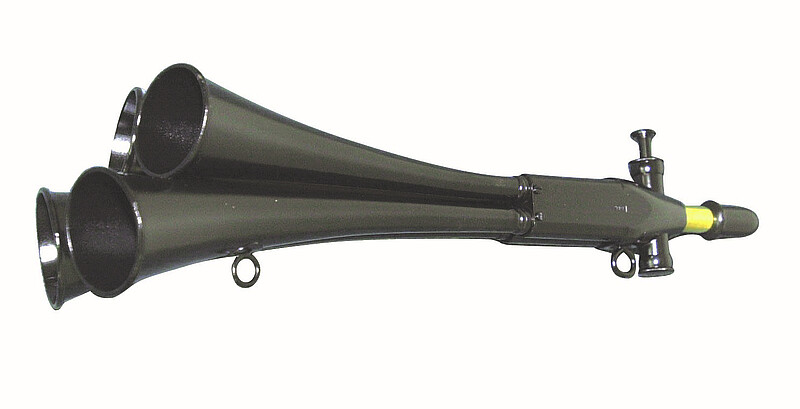Signalling equipment
Warning equipment needs the approval of the railway operator, if it does not itself supply this, since it can affect railway operation. As a rule, audible warning equipment is used, but visual warning equipment can be used in the dark. When deciding between a multi-tone horn and a loud volume horn it is important to ensure that the signal sound level is approximately 10 dB(A) above the ambient noise level. It must be established by a hearing test under the least favourable conditions to be expected (e.g. neighbourhood noise, trains passing on the other track, wearing ear protectors) that warnings are audible.
Multi-tone signal horn
The multi-tone signal horn must be carried by the lookout man even if the loud volume horn or electrical warning equipment is available. Should a piece of warning equipment fail, it should still be possible to warn the workers with the multi-tone signal horn. It is used where there is little noise and no loud equipment or where no machines are in use. These are mostly small work sites, for which only one lookout man is necessary in the immediate vicinity of the workers. As the mouthpiece can be frozen up with saliva residues, rain or snow in winter, it is always necessary to perform a functional check before working.
Loud volume horn (Tremolo)
The warning instrument "loud volume horn" is often used in railways, because it has a much greater range than a multi-tone signal horn. The signal is caused by the operation of the noise emitting knob by turning the handle up to 90° downward. The CO2 feed in both horns produces a mixed sound. If the loud volume horn has been in service for a long time, servicing and maintenance is necessary. However, a functional test must be done on this piece of warning equipment before the start of work and an audibility test must be performed.
Carrying out an audibility test
If an audibility test has been satisfactorily completed, the safety supervisor and the project manager should consider whether the least favourable acoustic conditions were present:
- the machines must be run under full load (maximum speed of the motors/engines).
- the machines must be used in accordance with their intended purpose (for example, when grinding or cutting of rails).
- trains must pass on the adjacent track.
In order to perform the audibility test while the machines are working, the supervisor must assess whether a neighbouring lookout men can hear the gang warning signal. The supervisor and the lookout should agree on hand signals for better communication. By lifting their hands, the workers signal in the noise level of the work place that they have clearly heard the gang warning signal. Only after ensuring the audibility of the gang warning signals by all workers, work should be carried out.
Whistle
The whistle is used as a warning instrument to warn workers and train drivers in rail transport and protect them from danger. The whistle has a very high tone (frequency), which can be heard even by people wearing ear muffs that are used with very loud tool and machine noise.
Warning and signal lamps
These lamps are used in the dark or when working in a tunnel if protection with several lookout men is necessary. Instead of a hand-signal a bright white hand lamp is held at head height as confirmation that a given signal has been received. The hand light can be switched to show a red light. In case of danger, a circular signal can be shown to the train.
Signal flag
In an emergency, the lookout man can give a circular signal with the signal flag and run towards the train so that the driver can make an emergency brake application and give the warning signal. In this case, workers could still leave the track area if there is any danger. The signal flag is held outside the case or inside in such a way that by pulling it out it is immediately recognizable as such.
Circular signal for the indication of an emergency
Daylight sign
A white-red-white flag or a red-and-white signal flag, another object or the arm is swung in a circle.
Night sign
A hand lamp or a lantern should show a red sign or a bright object that is swung in a circle.
The circular signal is given when a train or a shunting movement must immediately be brought to a stand.

